
The Kriegerdenkmal ("warrior memorial") in the Hofgarten in Munich was built for commemorating those killed in action in World War I from Munich. It is located on the eastern end of the Hofgarten, in front of the Bayerische Staatskanzlei.

The Kriegerdenkmal ("warrior memorial") in the Hofgarten in Munich was built for commemorating those killed in action in World War I from Munich. It is located on the eastern end of the Hofgarten, in front of the Bayerische Staatskanzlei.

In the middle of a rectangular pit an open crypt is located, containing the statue of a fallen soldier.
The 2.25 meters deep pit measures 28×17 meters and is clad in Muschelkalk. Four cornered stairs lead down into it. On the north Muschelkalk wall of this outer room is a relief of marching soldiers and in contrast, the southern wall has a relief of a burial ground.
The crypt itself consists of 12 blocks of stone which carry a 2 meters thick and 250 tons heavy roof panel. The stones form a room of 7.30×3.50 meters. 12 stairs – 5 on each long side and 1 on each short side – each one with 7 steps, lead down to the larger-than-life size monument of the fallen soldier.
The memorial was designed by sculptor Karl Knappe and the architects Thomas Wechs and Eberhard Finsterwalder. Bernhard Bleeker created the monument of the fallen soldier and its base of red marble. The original marble statue was replaced by a bronze cast in 1972, made by Thomas Wimmer, and is now exhibited in the Bavarian Army museum in Ingolstadt.
Rupprecht, Crown Prince of Bavaria, the son of the last Bavarian King, inaugurated the memorial site in 1924. [1] However, it was only entirely finished in 1928. It is now a cultural heritage.
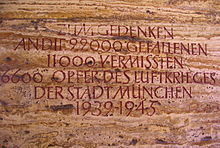
Originally, the names of the KIA from Munich were engraved into the walls. Due to the damage from World War II, the memorial was rebuilt without the names, as the old inscription was destroyed and the list of names that was originally used became lost. But instead the sentence "Zum Gedenken / an die 22.000 Gefallenen / 11.000 Vermissten / 6.600 Opfer des Luftkrieges / der Stadt München / 1939-1945" ("For the commemoration / of the 22,000 killed in action / 11,000 missing in action / 6,600 casualties of the aerial warfare / in the city of Munich / 1939-1945") was added on the inside.

The Englischer Garten is a large public park in the centre of Munich, Bavaria, stretching from the city centre to the northeastern city limits. It was created in 1789 by Sir Benjamin Thompson (1753–1814), later Count Rumford, for Prince Charles Theodore, Elector of Bavaria. Thompson's successors, Reinhard von Werneck (1757–1842) and Friedrich Ludwig von Sckell (1750–1823), advisers on the project from its beginning, both extended and improved the park.
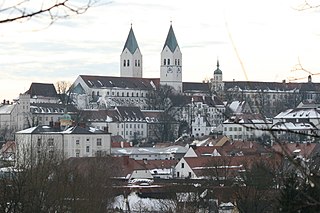
Freising is a university town in Bavaria, Germany, and the capital of the Freising Landkreis (district), with a population of about 50,000.
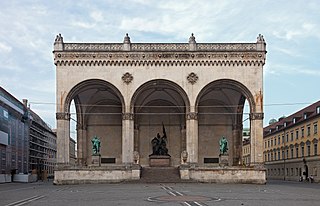
The Feldherrnhalle is a monumental loggia on the Odeonsplatz in Munich, Germany. Modelled after the Loggia dei Lanzi in Florence, it was commissioned in 1841 by King Ludwig I of Bavaria to honour the tradition of the Bavarian Army.
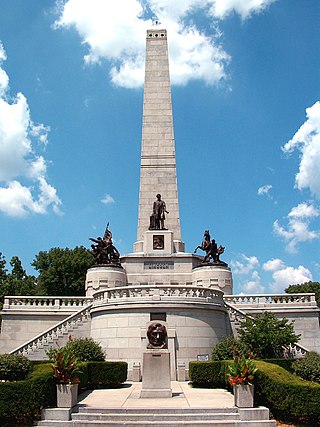
The Lincoln Tomb is the final resting place of Abraham Lincoln, the 16th President of the United States; his wife Mary Todd Lincoln; and three of their four sons: Edward, William, and Thomas. It is located in Oak Ridge Cemetery in Springfield, Illinois.

Agnes Bernauer was the mistress and perhaps also the first wife of Albert, later Albert III, Duke of Bavaria. Because his father, Ernest, ruling Duke of Bavaria at the time, considered this liaison with a commoner unbefitting his son's social standing, he clashed with his son over the matter and finally arranged to have Agnes condemned for witchcraft and drowned in the Danube in 1435. Her life and death have been depicted in numerous literary works, the most well known being Friedrich Hebbel's tragedy of the same name and the folk musical Die Bernauerin by the composer Carl Orff.

The Residenz in central Munich is the former royal palace of the Wittelsbach monarchs of Bavaria. The Residenz is the largest city palace in Germany and is today open to visitors for its architecture, room decorations, and displays from the former royal collections.

The Siegestor in Munich is a three-arched memorial arch, crowned with a statue of Bavaria with a lion-quadriga. The monument was originally dedicated to the glory of the Bavarian army. Since its restoration following World War II, it now stands as a reminder to peace.

The Befreiungshalle is a neoclassical monument on the Michelsberg hill above the town of Kelheim in Bavaria, Germany. It stands upstream of Regensburg on the river Danube at the confluence of the Danube and the Altmühl, i.e. the Rhine–Main–Danube Canal. It is just downstream of the Danube Gorge, towering above its lower end. It was commissioned by King Ludwig I of Bavaria to commemorate the victory over Napoleon in the Befreiungskriege of 1813–1815.

St. Michael's is a Jesuit church in Munich, southern Germany, the largest Renaissance church north of the Alps. The style of the building had an enormous influence on Southern German early Baroque architecture.

The Hofgarten is a garden in the center of Munich, Germany, located between the Residenz and the Englischer Garten.

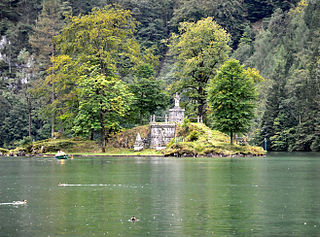
Christlieger is the name of the only island in the Königssee lake in Bavaria, Germany. It is located near the northern end of the lake, at 47°35′08″N12°35′17″E. It is also called Johannesinsel, after the marble statue of John of Nepomuk that was erected on the island in 1711.

Josef Bernhard Maria Bleeker was a German sculptor.

Ferdinand Miller, from 1875 von Miller and from 1912 Freiherr von Miller was an ore caster, sculptor and director of the Academy of Fine Arts, Munich. He also held a seat in the Royal Bavarian House of Lords, the Reichsrat.
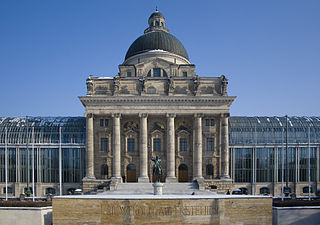
Bayerische Staatskanzlei is the name of a state agency of the German Free State of Bavaria and also of the appendant building.
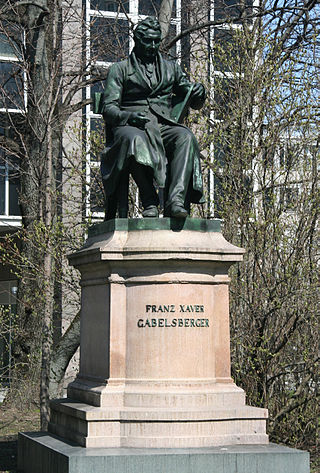
Memorial for Franz Xaver Gabelsberger is a monument located in Maxvorstadt, Munich, Bavaria, Germany. The monument is a bronze sculpture by the German sculptor Syrius Eberle. It was dedicated shortly after the hundredth anniversary of the birth of Franz Xaver Gabelsberger (1789-1849), the inventor of a cursive shorthand system. Casting was by Ferdinand von Miller.

The following outline is provided as an overview of and topical guide to Munich:
Lothstraße is a roughly 1.3 kilometer long street in Munich. It runs through the St. Benno district and forms the boundary between the municipality of Maxvorstadt, which lies southeast of the street, and the districts of Neuhausen and Schwabing-West, which are located northwest.

The Diana Temple in the Munich Hofgarten, the garden of the Munich Residenz, is a twelve-sided gazebo from the Renaissance period with eight open and four closed round arcades. It is the crossing point of the main and diagonal axes of the Hofgarten.

The Munich Old Town is part of the Bavarian capital Munich and has belonged to the city the longest, even if some places which are meanwhile districts of Munich, were mentioned long before Munich's documents spoke of the Old Town. The Old Town forms together with the district Lehel, the municipality No. 1 Altstadt-Lehel. The entire area of the Old Town is listed as both a historical ensemble as well as a historical monument listed in the Bavarian historical monument list.